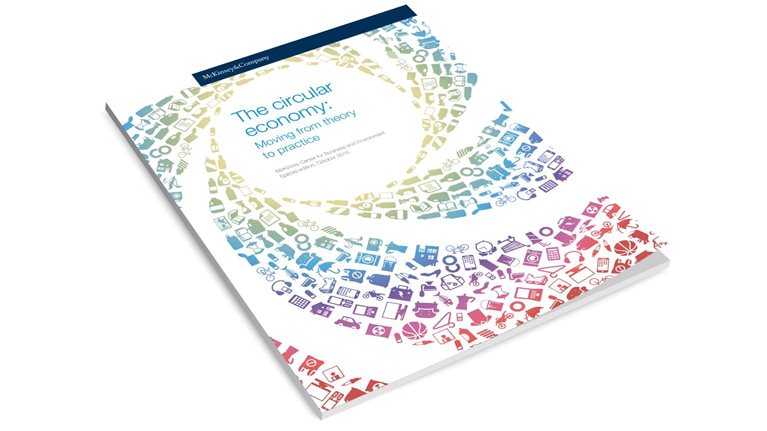Whenever over the past decade we have examined the chemical industry’s capital-markets performance, a very similar picture has emerged. On the basis of total returns to shareholders (TRS), the chemical sector has, over the long term, outperformed not only the overall market but also most of its customer industries and raw-material suppliers.1 Within chemicals, the commodity and specialty subsectors show similar performance, while diversified companies have trailed. There have been variations on the theme over time, with petrochemical players’ performance more affected by the naphtha-ethane spread and the commodity cycle, while specialty players have been more affected by end-market growth and mergers-and-acquisitions activity, but the variations have not changed the overall sunny picture.
Stay current on your favorite topics
The impetus behind this strong performance has been the chemical industry’s ability to significantly increase earnings on a base of total revenues and invested capital that has grown more slowly, at a rate tracking close to global GDP growth. This ability has been underpinned by the following factors.
First, the chemical industry has increased its productivity over time and has distinguished itself by holding onto the resulting profitability gains, unlike many other industries that also raised productivity but simply competed the gains away. How did the chemical sector achieve this? Looked at overall, the sector appears fragmented, but two decades of portfolio restructuring have created a highly concentrated industry structure in many segments. That has put those chemical companies in a strong bargaining position relative to customers and suppliers.
Next, the chemical industry has benefited tremendously from China’s economic growth of the past two decades. China’s capacity could not be built fast enough to meet domestic demand, so chemicals had to be imported. This allowed West European and North American players to grow while their home markets were experiencing near stagnation.
Last, we must keep in mind that the chemical industry has an intrinsically sound business model: its products enable the “world of things.” Without some support from the chemical industry, hardly any of what we touch, of the buildings we live in, the food we eat, and the healthcare we receive could exist. The industry as a whole is therefore positioned to profit from a wide range of trends, from sustainability to e-mobility, from commodity demand surges to major changes in consumer behavior.
Along with these strong fundamentals, there have been a number of positive developments that have benefited specific segments of the industry, and helped the industry’s overall capital-markets performance. The most notable have been the availability of stranded gas in the Middle East and shale gas in North America, and the upward trend in many agricultural-commodity prices from 2000 to 2013.
Turn of the tide?
But this golden era may be coming to an end. Some important indicators have changed over the past few years. While the industry’s 15-year performance still looks good, a closer look at the past five years is less favorable: not only have chemicals lagged the total stock market since 2011 in TRS performance but the industry’s return on invested capital (ROIC) performance has flattened, and for some chemical subsectors, decreased.
This slowdown in financial performance reflects important changes in the chemical industry’s fundamentals. First, the industry is finding it increasingly difficult to hold onto the benefits of its productivity-improvement efforts. Paradoxically, this is happening just when advanced analytics and digital approaches are creating a new wave of opportunities to accelerate productivity gains. Why is the industry having these difficulties? There are signs that one of the cornerstones of the industry’s performance—its concentrated industry structure—may be weakening. How is this showing? The level of competitiveness appears to be significantly increasing in many segments because of the number of new entrants, mostly Chinese, and related to this, overcapacity is increasingly a challenge in many product areas.
A second factor is slowing growth in global demand. The GDP growth rate in the all-important Chinese market has fallen and may decline further. Even more important is that China’s per capita chemical consumption is reaching the threshold where it is decoupling from GDP growth and is projected to lag behind that growth in the future. China has moved from its investment stage—built up infrastructure across the country while much of its population has equipped itself with new homes, consumer durables, autos, and other possessions—to an economy more characterized by services and “upgrades,” which provide much less demand for chemicals. A middle-class car that a Chinese buyer trades up to does not necessarily contain more polymers than an entry-level model.
Looked at globally, we estimate that the last decade’s 3.6 percent growth rate for petrochemicals may go down by between 0.5 and 2.0 percentage points over the next ten years, depending on assumptions for regional GDP growth. For an industry with an estimated capacity creep somewhere between 1 and 2 percent annually, this could be a dramatic shift. Other sectors are likely to see similar reductions in growth rates—although the growth in overall chemical demand will continue to outpace GDP. In agrochemicals, for example, changes in diet as well as the potential to tap enormous productivity reserves in the existing food chain could suppress overall chemical demand.
There are also signs of longer-term shifts. We think the specialties model is increasingly under threat. A long-standing belief in the industry is that moving portfolios downstream and to a higher specialties content is a reliable way to help solve the challenges of growth and value creation. But we are increasingly skeptical. The universe of specialties is not well defined and as a result is hard to quantify, but we think it is getting smaller. Innovation to develop new differentiated—and thus specialty—products has become a game of inches. With the exception of innovative crop protection, we would be hard pressed to name a single chemical blockbuster developed in the last ten years. Even in application development, the segments where consumers are willing to pay for leading-edge solutions are not getting bigger, since the fastest-growing markets (China and India) have only a limited appetite for premium grades. Expanding in application development will compensate for only part of the margin erosion in the upstream core business.
Digital innovations may further hasten this trend; an increase in e-commerce driven by distributors or platforms such as Alibaba could even accelerate this commoditization of specialty companies’ product and service offerings. In certain areas, such as agrochemicals, that have more of a B2C character, Internet platforms may become as disruptive as we have seen in other consumer spaces. Our skepticism about specialties is reinforced by our research, which shows that segment profitability already appears to be much more dependent on industry structure (in effect, the number of players) than on the technology content of companies’ offerings. But that industry structure is changing fast as many new—in particular, Chinese—players enter the game.
Next, the global playing field is leveling off again, and so potentially shutting off another growth avenue. Chemical production has historically tended to be local—produced in the region where it is consumed. But the last ten years have seen a departure from that pattern: significant imbalances in raw-material prices (the cost of stranded and shale gas versus oil), labor costs (China versus developed economies), or just regional mismatches in supply and demand (China growth) resulted in a significant internationalization of the chemical industry and related growth opportunities for many players. However, given the context of oil prices moving to lower levels since 2014 and Chinese labor costs rising, it is fair to speculate that this development might go into reverse in the coming years.
As if all of these shifts were not enough to deal with, the global chemical industry must also recognize that it has to operate in an environment that is increasingly nationalistic. The trade and investment policies of a number of emerging-market countries have always been somewhat protective (and may have become even more so recently), and the incoming US administration appears to embrace a similar attitude. As Brexit and other developments underline, a similar trend can even be observed in Europe.
In parallel with this resurgence of nationalism, state-owned enterprises (SOEs) are taking an increasing share in the industry. SOEs’ share dropped sharply during the 1980s and ’90s, when many governments sold their stakes in national oil companies, many of which owned significant chemical activities. With the rise of China and other developing countries, this trend has reversed. SOEs, however, often are held accountable to different standards than private and listed players—financially, strategically, and otherwise. They also tend to have much deeper pockets than publicly traded companies, which may find it difficult to compete when it comes to the development of new technologies.
This list would not be complete without a mention of the debate around the circular economy. This is mostly relevant for plastics, but since plastics consume the majority of petrochemical products, this has the potential for industry-wide impact. We estimate that roughly two-thirds of all plastic ends up in a landfill or the environment at large. Because plastic waste degrades slowly, it accumulates, and it is not unlikely that the chemical industry will become subject to regulation and pressure from customers to do more regarding recycling and demand reduction. Given the rather low growth rates projected for the sector, as previously discussed, such regulation could potentially result in a scenario in which the need for conventionally produced material would not only stop growing but even (though not in the short term) could shrink.
If just a few of these shifts gain substantial momentum, the chemical industry will face a decade very different from, and much tougher than, the last one. What are the implications for the industry?
Would you like to learn more about our Chemicals Practice?
Into a new world
The first and perhaps most significant implication would be that with growth rates only a little above annual capacity creep, there will be less need for new builds. Most new investments will either replace existing assets or need to displace others. For example, the new crackers in North America will target Asian markets and compete with exports from Middle East producers. The latter’s exports to Europe may increase as a result, increasing pressure on European petrochemical players in the medium term. While this scenario seems remote in today’s environment of record profitability for European petrochemical makers, good times rarely last forever, and the need for closures could resurge. More broadly across the industry, companies could be forced to restructure in almost all parts of the world, and we foresee players trying to attain greater economies of scale through new waves of M&A.
The only major exceptions might be India—where all indicators suggest that the local growth is going to continue, albeit from a low base—and China. But many areas of the Chinese chemical market these days are already oversupplied and overserved. We would argue that Chinese supply needs a broad and drastic consolidation.
Incumbent specialty-chemical players must prepare for further encroachment of commoditization and erosion of their historical advantages when attackers from developing markets gain more experience and become increasingly technologically savvy. The value-add potential of many Western specialty-chemical conglomerates will be challenged even more intensely than today, and so will their questionable claim that they can upgrade their portfolio in a way that generates value for shareholders.
At the same time, the long-heralded shift of the chemical industry’s center of gravity to Asia will actually take place. As much as Western players have tried to prepare themselves for this development, many still have only a limited grasp of what this will mean and the mind-set shifts required to face the fact that they will move from the center of the industry to its sidelines. The historical track record of multinational companies in China and other Asian countries has been mixed at best. At some point, they will need to consider much closer partnerships with Chinese players to grab hold of one of the last opportunities to become an insider in what will be the largest chemical market. There may be a fit here with the interests of local companies: as Chinese players grasp the opportunities for consolidation in their home market and expansion globally, they may value access not just to Western companies’ technology but also to their successful business approaches.
As a general statement, strategies for chemical companies may become simultaneously simpler and more challenging. They may become simpler because the imperatives of productivity improvement and functional excellence—in other words, executing a chemical-business model better than most competitors in the field—will be even more obvious than today. Without this executional excellence, companies will lack the financial strength and the credibility to lead in a game that will include a lot of M&A. Strategy development, however, will also become much more difficult: it will be much more challenging to identify the remaining opportunities for growth that exceeds GDP and to develop approaches to capture those opportunities in a value-generating way.
We are the first to acknowledge that any attempt to look into the future has limitations, and we present this perspective based on careful observation of the industry as a starting point for participants thinking about strategies for the next decade. As chemical companies head into this new and more challenging territory, they need to take stock of their strengths and weaknesses. Here are some questions to advance that reflection:
- How is the industry structure of the segments in which you participate going to evolve, and what are the implications for future profitability?
- How can you increase your presence in China as a foreign-based company, in view of the changes under way that we have outlined in this article? And if you are a Chinese company, what role will you play in a likely consolidation of the industry?
- What are your strengths, and how can you build on them through transformational M&A to become a champion in your target segments?
- What will be the most value-creating operating models for multibusiness companies that straddle specialties and commodities?
- How will you use digital to ride the next wave of commercial, supply-chain, and operations performance improvement?


